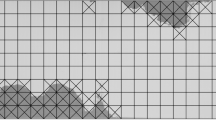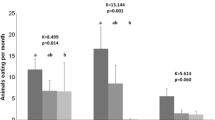Abstract
The current demographic expansion of red deer populations in the northern hemisphere has led to conflicts at the levels of health, the economy, and conservation. Potential tools for deer management include the delivery of contraceptives that impair reproduction in order to control populations or the delivery of treatments/vaccines in order to control health. To successfully implement these control strategies, it is necessary to develop suitable methods with which to deliver treatments to red deer in field settings. The objectives of this study were (i) to evaluate the specificity and palatability of three bait types—alfalfa, feed, and molasses-based—for red deer (Cervus elaphus) and (ii) to describe the constraints that limit or enhance the effectiveness of the bait deployment method—on the ground or in specific red deer feeders—for the oral delivery of treatments to red deer in Mediterranean ecosystems. Our results show that alfalfa baits are the least palatable but the most deer-selective type of bait, whereas feed and molasses baits are highly palatable but low specific (mean bait consumption rates on the ground were 0.811, 0.949, and 0.955, respectively). The appropriate season for oral treatments using alfalfa baits both on the ground and in deer feeders is late summer (mean bait consumption rate on the ground for alfalfa-based baits was 0.939 in summer period). These results indicate that alfalfa baits are sufficiently palatable and specific in summer for them to be an efficient means to deliver treatments to red deer in Mediterranean ecosystems.


Similar content being viewed by others
References
Acevedo P, Ruiz-Fons F, Vicente J, Reyes-García AR, Alzaga V, Gortázar C (2008) Estimating red deer abundance in a wide range of management situations in Mediterranean habitats. J Zool 276:37–47. https://doi.org/10.1111/j.1469-7998.2008.00464.x
Asa CS, Porton IJ (2005) Wildlife contraception: issues, methods, and applications. Johns Hopkins University Press, Baltimore
Ballesteros C, Perez de la Lastra J, la Fuente J (2007) Recent developments in oral bait vaccines for wildlife. Recent Pat Drug Deliv Formul 1:230–235. https://doi.org/10.2174/187221107782331610
Ballesteros C, Gortázar C, Canales M, Vicente J, Lasagna A, Gamarra JA, Carrasco-García R, Fuente J (2009) Evaluation of baits for oral vaccination of European wild boar piglets. Res Vet Sci 86:388–393. https://doi.org/10.1016/j.rvsc.2008.09.003
Ballesteros C, Vicente J, Carrasco-García R, Mateo R, de la Fuente J, Gortázar C (2011a) Specificity and success of oral-bait delivery to Eurasian wild boar in Mediterranean woodland habitats. Eur J Wildl Res 57:749–757. https://doi.org/10.1007/s10344-010-0483-9
Ballesteros C, Vicente J, Morriss G, Jockney I, Rodríguez O, Gortázar C, de la Fuente J (2011b) Acceptance and palatability for domestic and wildlife hosts of baits designed to deliver a tuberculosis vaccine to wild boar piglets. Prev Vet Med 98:198–203. https://doi.org/10.1016/j.prevetmed.2010.10.012
Blanco JC (1986) On the diet, size and use of home range and activity patterns of a red fox in Central Spain. Acta Theriol (Warsz) 31:547–552. https://doi.org/10.4098/at.arch.86-48
Boitani L, Mattei L, Nonis D, Corsi F (1994) Spatial and activity patterns of wild boars in Tuscany, Italy. J Mammal 75:600–612. https://doi.org/10.2307/1382507
Brauer A, Lange E, Kaden V (2006) Oral immunisation of wild boar against classical swine fever: uptake studies of new baits and investigations on the stability of lyophilised C-strain vaccine. Eur J Wildl Res 52:271–276. https://doi.org/10.1007/s10344-006-0048-0
Burnham KP, Anderson DR (2004) Model selection and multimodel inference. Springer, Berlin
Carrasco-Garcia R, Barasona JA, Gortazar C, Montoro V, Sanchez-Vizcaino JM, Vicente J (2016) Wildlife and livestock use of extensive farm resources in South Central Spain: implications for disease transmission. Eur J Wildl Res 62:65–78. https://doi.org/10.1007/s10344-015-0974-9
Castillo L, Fernandez-Llario P, Mateos C et al (2011) Management practices and their association with Mycobacterium tuberculosis complex prevalence in red deer populations in Southwestern Spain. Prev Vet Med 98:58–63. https://doi.org/10.1016/j.prevetmed.2010.11.008
Côté SD, Rooney TP, Tremblay J-P, Dussault C, Waller DM (2004) Ecological impacts of deer overabundance. Annu Rev Ecol Evol Syst 35:113–147. https://doi.org/10.1146/annurev.ecolsys.35.021103.105725
Cross ML, Buddle BM, Aldwell FE (2007) The potential of oral vaccines for disease control in wildlife species. Vet J 174:472–480. https://doi.org/10.1016/J.TVJL.2006.10.005
Díez-Delgado I, Sevilla IA, Romero B, Tanner E, Barasona JA, White AR, Lurz PWW, Boots M, de la Fuente J, Dominguez L, Vicente J, Garrido JM, Juste RA, Aranaz A, Gortazar C (2018) Impact of piglet oral vaccination against tuberculosis in endemic free-ranging wild boar populations. Prev Vet Med 155:11–20. https://doi.org/10.1016/j.prevetmed.2018.04.002
Dressel D (2017) Development of strategies to orally deliver vaccine for bovine tuberculosis to white-tailed deer of northeastern lower Michigan. Thesis. Michigan State University
Efron B (2004) The estimation of prediction error: covariance penalties and cross-validation. J Am Stat Assoc 99:619–632. https://doi.org/10.1198/016214504000000692
Enticott G (2015) Public attitudes to badger culling to control bovine tuberculosis in rural Wales. Eur J Wildl Res 61:387–398. https://doi.org/10.1007/s10344-015-0905-9
Fagerstone KA, Miller LA, Killian G, Yoder CA (2010) Review of issues concerning the use of reproductive inhibitors, with particular emphasis on resolving human-wildlife conflicts in North America. Integr Zool 5:15–30. https://doi.org/10.1111/j.1749-4877.2010.00185.x
Fierro Y, Gortazar C, Sánchez J (2005) Patent: Deer feeders 10
Gavier-Widén D, Meredith A, Duff JP (2012) Infectious diseases of wild mammals and birds in Europe. Wiley, Hoboken
González-Barrio D, Fernandez-de-Mera IG, Ortiz JA et al (2015) Long-term dynamics of Coxiella burnetii in farmed red deer (Cervus elaphus). Front Vet Sci 2:74. https://doi.org/10.3389/fvets.2015.00074
González-Barrio D, Ortiz JA, Ruiz-Fons F (2017) Estimating the efficacy of a commercial phase I inactivated vaccine in decreasing the prevalence of Coxiella burnetii infection and shedding in red deer (Cervus elaphus). Front Vet Sci 4:208. https://doi.org/10.3389/fvets.2017.00208
Gordon IJ, Hester AJ, Festa-Bianchet M (2004) The management of wild large herbivores to meet economic, conservation and environmental objectives. J Appl Ecol 41:1021–1031. https://doi.org/10.1111/j.0021-8901.2004.00985.x
Gortázar C, Acevedo P, Ruiz-Fons F, Vicente J (2006) Disease risks and overabundance of game species. Eur J Wildl Res 52:81–87. https://doi.org/10.1007/s10344-005-0022-2
Joffre R, Rambal S, Systems JR-A (1999) The dehesa system of southern Spain and Portugal as a natural ecosystem mimic. Agrofor Syst 45:57–79
López V, González-Barrio D, Lima-Barbero JF, Ortiz JA, Domínguez L, Juste R, Garrido JM, Sevilla IA, Alberdi P, de la Fuente J, Gortázar C (2016) Oral administration of heat-inactivated Mycobacterium bovis reduces the response of farmed red deer to avian and bovine tuberculin. Vet Immunol Immunopathol 172:21–25. https://doi.org/10.1016/j.vetimm.2016.03.003
Miller R, Kaneene JB, Fitzgerald SD, Schmitt SM (2003) Evaluation of the influence of supplemental feeding of white-tailed deer (Odocoileus virginianus) on the prevalence of bovine tuberculosis in the Michigan wild deer population. J Wildl Dis 39:84–95. https://doi.org/10.7589/0090-3558-39.1.84
Murray MH, Becker DJ, Hall RJ, Hernandez SM (2016) Wildlife health and supplemental feeding: a review and management recommendations. Biol Conserv 204:163–174. https://doi.org/10.1016/j.biocon.2016.10.034
Olea L, San Miguel-Ayanz A (2006) The Spanish dehesa. A traditional Mediterranean silvopastoral system linking production and nature conservation. In: 21st General Meeting of the European Grassland Federation. pp 1–15
Palmer MV, Stafne MR, Waters WR, Thacker TC, Phillips GE (2014) Testing a molasses-based bait for oral vaccination of white-tailed deer (Odocoileus virginianus) against Mycobacterium bovis. Eur J Wildl Res 60:265–270. https://doi.org/10.1007/s10344-013-0777-9
Pedersen AB, Fenton A (2015) The role of antiparasite treatment experiments in assessing the impact of parasites on wildlife. Trends Parasitol 31:200–211. https://doi.org/10.1016/j.pt.2015.02.004
Pérez-González J, Barbosa AM, Carranza J, Torres-Porras J (2010) Relative effect of food supplementation and natural resources on female red deer distribution in a Mediterranean ecosystem. J Wildl Manag 74:1701–1708. https://doi.org/10.2193/2009-130
Pineda FD, Montalvo J (1995) Dehesa systems in the western Mediterranean. Conserv biosiversity Outs Prot areas 107–122
Putman R, Apollonio M, Andersen R (2011) Ungulate management in Europe: problems and practices. Cambridge University Press, Cambridge
R Core Team (2018) R: a language and environment for statistical computing
Ruiz-Fons F, Sánchez-Matamoros A, Gortázar C, Sánchez-Vizcaíno JM (2014) The role of wildlife in bluetongue virus maintenance in Europe: lessons learned after the natural infection in Spain. Virus Res 182:50–58. https://doi.org/10.1016/j.virusres.2013.12.031
Shapiro L, Eason C, Bunt C, Hix S, Aylett P, MacMorran D (2016) Efficacy of encapsulated sodium nitrite as a new tool for feral pig management. J Pest Sci 89:489–495. https://doi.org/10.1007/s10340-015-0706-7
Sicilia M (2011) Ecología y comportamiento de ungulados en simpatria en un ambiente mediterráneo: interacciones entre especies nativas y exóticas de interés cinegético. Universidad de Castilla-La Mancha
Sorensen A, van Beest FM, Brook RK (2014) Impacts of wildlife baiting and supplemental feeding on infectious disease transmission risk: a synthesis of knowledge. Prev Vet Med 113:356–363. https://doi.org/10.1016/j.prevetmed.2013.11.010
Thomas J, Risalde MÁ, Serrano M, Sevilla I, Geijo M, Ortíz JA, Fuertes M, Ruíz-Fons JF, de la Fuente J, Domínguez L, Juste R, Garrido J, Gortázar C (2017) The response of red deer to oral administration of heat-inactivated Mycobacterium bovis and challenge with a field strain. Vet Microbiol 208:195–202. https://doi.org/10.1016/j.vetmic.2017.08.007
Vargas JD, Calvo JC, Aparicio MA (1995) Red deer (Cervus elaphus hispanicus) management in the dehesa system in Central Extremadura, Spain. Agrofor Syst 29:77–89. https://doi.org/10.1007/BF00711283
Vicente J, Höfle U, Garrido JM, Fernández-de-Mera IG, Juste R, Barral M, Gortazar C (2006) Wild boar and red deer display high prevalences of tuberculosis-like lesions in Spain. Vet Res 37:107–119. https://doi.org/10.1051/vetres:2005044
Vicente J, Höfle U, Garrido JM, Fernández-de-mera IG, Acevedo P, Juste R, Barral M, Gortazar C (2007) Risk factors associated with the prevalence of tuberculosis-like lesions in fenced wild boar and red deer in south central Spain. Vet Res 38:451–464. https://doi.org/10.1051/vetres:2007002
Zuur AF, Ieno EN, Elphick CS (2010) A protocol for data exploration to avoid common statistical problems. Methods Ecol Evol 1:3–14. https://doi.org/10.1111/j.2041-210X.2009.00001.x
Acknowledgments
We would like to acknowledge the collaboration of Mr. Óscar Rodríguez from S3 and the “Organismo Autónomo de Parques Nacionales (OAPN)-Centro Quintos de Mora” for collaborating and facilitating the access to the study sites. Dr. Mitchell V. Palmer from the National Animal Disease Center of the US Department of Agriculture (USDA) is acknowledged for his advice in the adaptation of the molasses baits to our study. The authors would also like to thank Eladio Gómez Alfaro and students at IREC for their technical assistance. We additionally acknowledge the collaboration of gamekeepers and environmental agents on the study sites who kindly assessed us as regards the location of bait deployment points and during the development of the study.
Funding
This study was funded by the Spanish Ministry for Science, Innovation and Universities (MCIU) and the European Regional Development Fund (FEDER) through grants “AGL2014-56305” and “CGL2017-89866R.” JMG was supported by an FPI grant from MCIU (BES-2015-072206), whereas DGB was supported by the Juan de la Cierva program of MCIU. LCM acknowledges funding from grant INIA E-RTA2015-00002-C02-02 and contract PEJ2018-003155-A from MCIU.
Author information
Authors and Affiliations
Corresponding author
Additional information
Publisher’s note
Springer Nature remains neutral with regard to jurisdictional claims in published maps and institutional affiliations.
Rights and permissions
About this article
Cite this article
Martinez-Guijosa, J., Casades-Marti, L., González-Barrio, D. et al. Tuning oral-bait delivery strategies for red deer in Mediterranean ecosystems. Eur J Wildl Res 66, 51 (2020). https://doi.org/10.1007/s10344-020-01389-8
Received:
Revised:
Accepted:
Published:
DOI: https://doi.org/10.1007/s10344-020-01389-8




